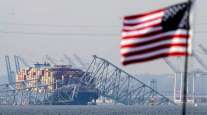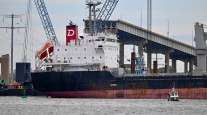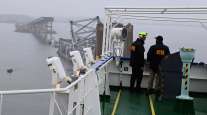Baltimore-Area Truckers Struggle to Find Loads
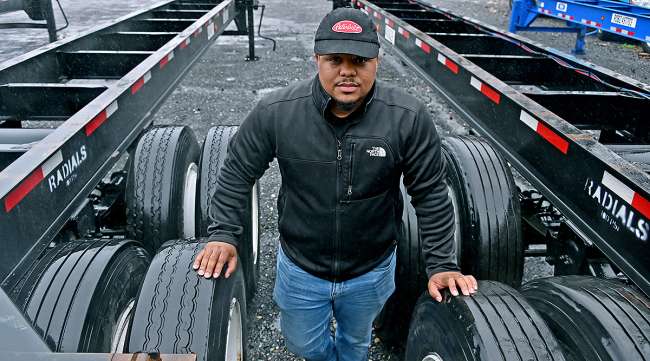
[Stay on top of transportation news: Get TTNews in your inbox.]
BALTIMORE — On the morning an outbound containership destroyed the Francis Scott Key Bridge, Leander Bowling absorbed the shock along with the rest of the world when he got a text from the Port of Baltimore.
With the Patapsco River blocked to vessels, Seagirt Marine Terminal would stop taking export cargo at 11 a.m. — until further notice.
Bowling, a 40-year-old driver who bought his own semi-truck five years ago, had a job lined up that day to deliver a container to the port, but he needed to drive nearly two hours to a shipper in Pennsylvania to pick up a 90,000-pound load of tree trunks, then haul it back to Seagirt. From his home near White Marsh, Md., not far from where the steel bridge had stood for nearly 50 years, he was against the clock.
“I was able to make the port, but after that, the rest of the loads were canceled. I ran four more loads that week,” outside the port, he said. “The truck’s been parked pretty much ever since. Everything is at a standstill.”
Like thousands of workers who depend on the port, now closed to ship traffic, truckers have found themselves sidelined and facing uncertainty. Roughly 3,000 trucks a day come into the state-owned terminal alone. The drivers are counted among a daily workforce of 8,000 people, including terminal, rail and tugboat operators and pilots, who have been affected directly.
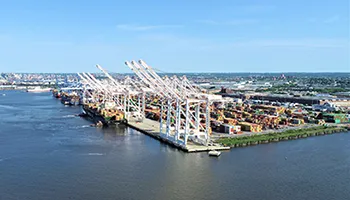
The Seagirt Marine Terminal at the Port of Baltimore. (maryland.gov)
Many of the truckers, who take jobs as they come up, negotiating rates for cargo as varied as diapers and tires, are independent contractors who fear they won’t be able to tap into unemployment or other help. Most in the Baltimore area make deliveries within a day’s drive and aren’t able to travel farther.
The head of a state trucking association said April 4 that federal, state and local officials have agreed to many measures the group requested to help truck drivers, including offering some financial assistance and making it easier to access other states’ ports, where ships are being diverted.
“Any and all options for accessing funding are going to be important to our members because the port’s essentially dried up now,” said Louis Campion, president and CEO of the Maryland Motor Truck Association. “So many of them are going to struggle to survive without it.”
Crews have begun the difficult task of removing bridge wreckage and the freighter to clear the shipping channel. Authorities have recovered the bodies of two of the six road workers who fell into the river. They’re still searching for four others presumed dead.
The Army Corps of Engineers said April 4 it tentatively expects to restore access to the port to “normal capacity” by the end of May. Temporary channels suitable for smaller vessels and barges have opened so far. Normally, $100 million to $200 million of goods sails in and out daily. The port ranks first among the nation’s ports for the volume of autos and light trucks, heavy farm and construction machinery, and imports of sugar and gypsum.
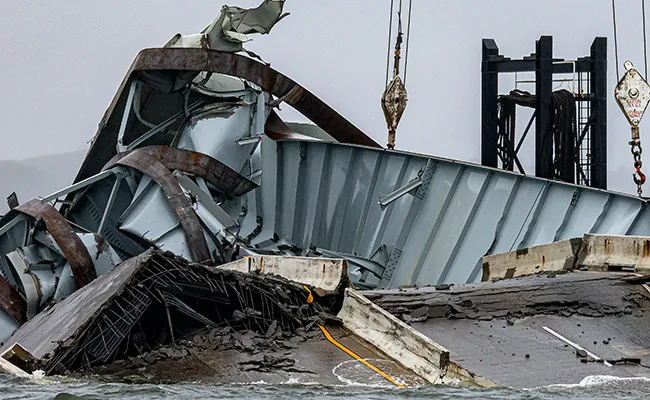
Part of the collapsed Francis Scott Key Bridge is pictured April 3. (Julia Nikhinson/Associated Press)
Meanwhile, workers like Bowling are left wondering what to do and how to pay mortgages, rent, groceries and other bills. Trucks may be parked, but their owners still must make payments on loans and insurance.
To make ends meet, Bowling has been delivering food for DoorDash, even though the cost of fueling his diesel pickup cuts into what he can pocket.
“It’s nowhere near what I was making driving my big truck, but it’s better than not making anything,” said Bowling, the father of a teenage son and daughter.
Before the accident, Robee Trucking’s 10 drivers, a mix of employees and contractors, typically handled three containers a day each to or from the port, said Ryan Roberson, a driver and owner of the fleet along with Robee Logistics. His company works with brokers and freight forwarders to take port delivery orders.
Now, they’re handling “zero,” he said, while making sure his truck parked in a Middle River, Md., yard still started. Some of his drivers have picked up temporary jobs, such as trash hauling, Uber driving or food delivery.

Another view of a section of the collapsed Francis Scott Key Bridge on April 3. (Julia Nikhinson/Associated Press)
A former independent driver who started his company 10 years ago, Roberson said he’s managing through prayer, hope and “having faith in trucking.” The city resident has applied for a Small Business Administration loan but is hoping grants become available.
“I love what I do, and I don’t really see myself doing anything else,” Roberson said. “This is what I know. I’ve been successful, and I’ve had hard times too. It’s just fighting through it.”
Further complicating things, the standstill has led to bidding wars for the work that’s left, pushing rates lower.
“It’s crazy. Everybody’s kind of fighting over the same freight,” Roberson said. “You might get an OK today, and then tomorrow they might say, ‘I’ve got another carrier who can do it for $300 cheaper.’ ”
We’re technically port workers as well. We don’t have a union to stand behind us, but we are the reason that things get in and out of the port.
Truck driver Leander Bowling
He was about to take a job to Norfolk, Va., that would have paid $1,500 round trip, but by the next day, the rate dropped in half, for one-way only. While some drivers will take such work, others are reluctant, knowing they’ll be on the hook for hundreds of dollars in fuel costs and the potential for maintenance problems without a guarantee they’ll more than break even.
“If I were to go down to Norfolk right now, it would cost me $300 just in fuel alone, four hours down and four hours back, a whole day,” Roberson said. He’s been calling his drivers and saying, "Hey this is what I’m seeing. Do you want to do it, nay or yay?"
Roberson estimated that local drivers account for more than half the trucking around the port.
“They are local trucks … they go from here to 30, 40, 50 miles, that’s it, and come right back,” he said. “Going from Baltimore and to have to drive to Norfolk, you’re talking 250 miles, one way. It’s definitely a change in the dynamic of the drivers that are available to even drive that far.”
Greg Hewitt of DHL Express considers whether the trucking industry is prepared for a greener future. Tune in above or by going to RoadSigns.ttnews.com.
It’s not a simple matter or even possible for some to merely follow cargo to another port. Roberson said his trucks are registered in other ports, but not the drivers, who have to appear in person to get credentials.
Bowling worries he won’t qualify for assistance being discussed for port workers and hopes help in the form of forgivable loans or grants is on the way.
“I’m trying to hold on for as long as I can,” Bowling said. “We’re technically port workers as well. We don’t have a union to stand behind us, but we are the reason that things get in and out of the port. … If there were no trucks, nobody would be able to get the things that they needed on a day-to-day basis.”
State legislators are crafting a proposal to create a temporary financial relief program for people who regularly perform paid work at the port, can’t return to work because of the closure or don’t qualify for unemployment while the port is closed, which is expected to include trucking. The Baltimore Board of Estimates approved a $1 million transfer to the city’s civic fund to be paid out to employers with city residents on their payrolls whose jobs have been affected by the collapse.

Campion
As of April 4, Campion said, many of the measures the trade group proposed in a letter to Maryland Transportation Secretary Paul Wiedefeld had been put in place. Also April 4, the Federal Motor Carrier Safety Administration began allowing drivers to temporarily extend their maximum allowable drive time of 11 hours in a 14-hour window by two hours while still requiring a 10-hour minimum rest break. That will enable Baltimore-area truckers to make a round trip to Norfolk.
Kathleen Kropp, 74, who ran restaurants before starting Perry Hall, Md.-based trucking company Triple H 20 years ago, said she mostly worries about the drivers she thinks of as her sons.
Kropp, who is an agent for a larger motor carrier, American Road Lines, works with Reno, Nev.-based ITS Logistics and other customers that transport freight from ports to distribution centers or stores. She coordinates daily jobs for 15 owner-operator drivers who travel within a 100-mile radius of Baltimore and return home every night. (ITS Logistics ranks No. 56 on the Transport Topics Top 100 list of the largest logistics companies in North America.)
They typically handle 50 to 60 loads a week. This week, they only picked up 11, from ships docked at Seagirt before the bridge fell.
“There’s nothing for anyone to pick up,” she said. “The truck drivers have truck payments to make; they have families to feed. They work very hard for their money. It’s not an easy job.”
Want more news? Listen to today's daily briefing below or go here for more info:
Distributed by Tribune Content Agency, LLC



